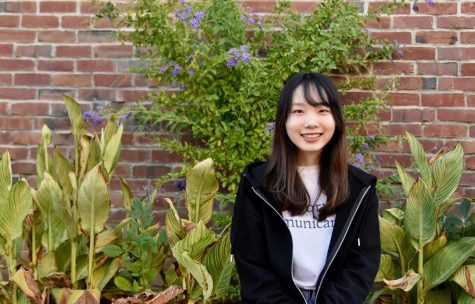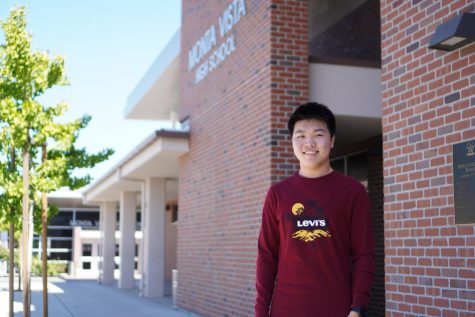Inner battles
Exploring the impact individuals can make in the lives of students facing internal struggles
October 25, 2019
He sat on the cool concrete and opened his lunch. He admired the heaps of pork and rice neatly packed into the colorful plastic containers — a sign of his mother’s love and dedication.
His mother got up at 6:00 a.m. each morning to cook his lunch, and she always reminded him to finish all his food. So former Homestead High School student Xiao Guo took his mother’s words to heart and made sure to eat every bit of his lunch, not wasting a single grain of rice. When other students saw the sumptuous meals he brought to school, they began to approach him and take bits of his meals. They slowly made it a habit to grab some of Guo’s food each day, amused by his protective behavior around his lunch. It was not until another student decided to stop Guo’s classmates from teasing him and sit down to eat lunch with Guo that this behavior finally came to an end.
“This girl, Michelle, stepped in to join Guo for lunch and things have changed ever since,” Chinese teacher I-Chu Chang said. “He was willing to share his food with others, which he never wanted to in the past, and he even helped another transferring student to have company on campus. I think it’s just all because of this Michelle. She cared and she stepped out and made a difference, and I think everyone can be a Michelle.”
Chang got to know Guo very well, as he often came to her room outside of class time. She notes that Guo was socially awkward and did not have many friends as a result. In the midst of his loneliness and social isolation, Michelle became a key figure who uplifted Guo and helped him become more friendly and interactive, according to Chang.
The impact that one person can have on another is further explored by Psychotherapist and Marriage and Family Therapist Kaltana Asok. Asok explains that one person can have a sizable impact on another person if they come at a significant time in one’s life. She adds that this is especially pertinent to teenagers who may not have a role model in their immediate family structure.
“Teenagers, as they develop their identity, will look around for others who they might view as heroic in their lives, or even as being different and exciting,” Asok said. “This is often not a conscious process. So… an adult [might look] back at their lives and [say], ‘Oh, you know when I was a teenager, I had a very hard time with my mom, but there was this aunt who was cool and exciting and was doing really interesting things in her life. She gave me an opportunity to think about things differently.’”
Asok explains one particular experience in which she personally helped a young woman who felt cultural pressure from her parents to pursue a STEM major. Although the young woman was not interested in these subjects, her parents thought that following the STEM path was the most ideal way to ensure a “certain level of material comfort in the world.”
“Her parents thought, ‘I just don’t want my child to experience the hardships, which is why we’re trying to make her do X, Y and Z,’” Asok said. “I helped the parents be less flooded by their emotional experiences or fear in a new country. It also helped the teenager to say to her mom and dad, ‘Hey, I am not you. I am not afraid and I don’t need your lifestyle. I can live a different kind of lifestyle and still be happy and productive.’”
As a child, junior Prerana Bathula faced a different type of internal struggle. She was diagnosed with alopecia areata, an autoimmune disease which results in hair loss. To adjust to her condition, Bathula began wearing wigs in fourth grade, switching between several before consistently wearing the same one in sixth grade.
“I knew that everything was a [big] deal and people would actually pay attention and care starting from middle school,” Bathula said. “I think it was better because I wore wigs and not as many people could tell, but the people that did know and didn’t like me, I think I heard that they spread rumors, which didn’t feel good.”
Along with dealing with her peers’ perception of her, Bathula was also physically restricted by her condition. Due to her use of wigs, she was unable to pursue sports like basketball or soccer, which she had wanted to explore as a child. In P.E. class, Bathula needed to constantly hold her bangs down when running. As she became more apprehensive about participating in sports, one of her teachers helped motivate her to push her limits.
“I think if my teachers did know, they’d be really nice about it, and they would try to help me, like especially [in] freshman year [with] Ms. [Julie] Sullivan,” Bathula said. “I ended up telling her in the first week of school, and then she was really nice about it. I kind of wanted to skip the swimming unit, but she was like, ‘It’ll be fine.’ And then I just did it. And I did really well.”
At school, Asok expands on the fact that teachers can become significant figures for students simply by expressing an interest in the students’ personal concerns. By reaching out to students who appear to be struggling, teachers can leave a lasting impact on students’ lives.
“I think, [for] a teacher, just by asking, ‘What kind of pressure are you feeling? I see your struggle. I see that you want something that is different from what your family wants for you’ — even a small recognition of the fact goes a long way,” Asok said. “Because the student will carry with them … the memory of the teacher who was able to say, ‘I saw you. I recognize your struggle.’”
Chang agrees with Asok, adding that it is these small but meaningful actions that create a better atmosphere at school. She encourages students to break out of their comfort zone and reach out to people who are alone.
“Just observe a little more,” Chang said. “I think for students, very often [they] are focusing on our stuff and only care about friends. We are very comfortable being in a circle with the same group of friends and don’t want others to join, to break the harmony or something. They feel like, ‘We’re cool together.’ However, I feel like when we resist or when we don’t open up we might lose the opportunity to get to meet another cool person, you never know, and then we just leave someone out there struggling. Just be more accepting and open to others.”
While Asok believes it is important to approach others who appear to be having a hard time, she recognizes the difficulties in getting the person to open up about their struggles. Rather than alienating a person for their personal struggles, Asok explains that it is important to show an openness towards talking about potentially sensitive topics.
“It might be good to compare the situation with a broken leg,” Asok said. “A broken leg is very obvious, and people will be helping the student carry her books, or his books. They would say, ‘How’s your foot?’ They might sign encouraging words on her cast or his cast. It becomes something that’s okay to talk about.”
Chang explains that taking these steps creates an inclusive community and can reward both the helper and the person being helped. In fact, her own experiences helping students inspired her to be who she is today.
“You’ll learn that there is another level of happiness when you are able to help and you feel really content inside,” Chang said. “This is what made me want to be a teacher. That happened 17 years ago, the Xiao Guo story. Now, 17 years later, I still believe the same thing. To help other people, to help each other.”



















